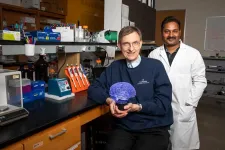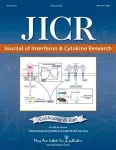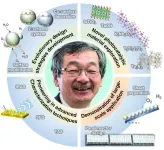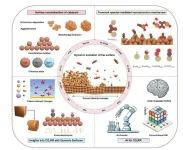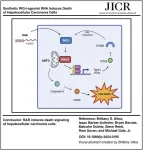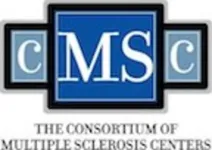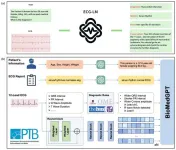(Press-News.org) CHAMPAIGN, Ill. — A genetic mutation found in two human patients with schizophrenia also increased schizophrenia-related behaviors in mice with the same mutation, a rare finding of a direct genetic link to psychosis, report researchers at the University of Illinois Urbana-Champaign and colleagues in Massachusetts and Germany.
The mutation increases levels of glycine decarboxylase, or GLDC, an enzyme responsible for regulating glycine in the brain. Glycine activates receptors for the neurotransmitter glutamate, called NDMA receptors.
“The genetics of schizophrenia is very complex, and it is rare that mutations found in patients can be linked directly to the disease,” said study leader Uwe Rudolph, a professor of comparative biosciences at Illinois. “Schizophrenia is not yet diagnosed by any kind of lab test or imaging; it’s still a clinical diagnosis based on symptoms. The hope is that these kinds of rare mutations could lead us to the biochemical and physiological pathways that are important to study.”
The study began when a genetic mutation was found in two patients with schizophrenia at McLean Hospital in Belmont, Mass. They had multiple copies of a section of DNA that included the gene for GLDC. Curious as to whether the mutation contributed to their symptoms, the McLean team studying the patients reached out to Rudolph’s lab to create a line of mice with the same mutation.
The mice with mutations analogous to those in the human patients also showed schizophrenia-associated behaviors. To further narrow down the genetic link, the researchers next developed lines of mice with multiple copies of only a few genes contained within the larger chromosome segment repeated in the patients, then a single gene: GLDC.
“We found that extra copies of the GLDC gene alone were sufficient to render the schizophrenia-like behaviors we had observed,” said Rudolph, who also is affiliated with the Neuroscience Program and the Carl R. Woese Institute for Genomic Biology at Illinois.
To understand why multiple copies of the GLDC gene would be solely responsible for the behavioral symptoms, the researchers took a closer look at what was happening in the brains of the mice, specifically to the levels of glycine and the function of NDMA receptors.
“We hypothesized that extra copies of GLDC would result in a lower level of glycine in the brain, since it degrades glycine. Then there would not be enough glycine to help activate the NDMA receptors,” said Illinois postdoctoral researcher Maltesh Kambali, the first author of the paper. “We measured an increase in activity of the GLDC enzyme in the brains of our mice, which would point to that as well.”
However, when the researchers measured glycine levels in the brains of their mice, there did not seem to be a significant difference between those with the extra GLDC and healthy mice. So Rudolph’s team turned to colleagues in Germany who had developed sophisticated methods of tracking glycine in the brain.
The German team found that, while the overall amount of glycine in the whole brain was similar, the amount of glycine outside of the nerve cells and available to help activate NDMA receptors was significantly lower in a subregion of the hippocampus in the mice with multiple copies of GLDC.
To see why this region of the brain was so affected, Rudolph’s team then worked with researchers at Harvard Medical School to perform functional studies on the affected brain subregion, called the dentate gyrus. They identified decreased activity in the neural synapses, the active junctions that send signals between neurons. They pinpointed differences in long-term potentiation, a sustained strengthening of activity in the synapse during the learning process.
“We saw how glycine measurements and the long-term potentiation measurements were showing converging changes in this dentate gyrus region, but not in other regions of the hippocampus. It’s interesting because one theory links the development of psychosis to the activity in the dentate gyrus. So our findings fit with that theory,” Kambali said.
The Illinois team then conducted a biochemical analysis of the dentate gyrus in the mice with extra copies of GLDC. They found that some pathways previously implicated in schizophrenia had reduce activity, indicating that the increase of GLDC and associated decrease of glycine was indeed sufficient to inhibit the NMDA receptors’ function and was involved in the schizophrenia symptoms they had observed.
The researchers published their findings in the journal Molecular Psychiatry.
“This study demonstrated at multiple levels how GLDC functions as a novel regulator of NMDA receptors,” Rudolph said. “Dysfunction of NMDA receptors has been shown to be important in the pathophysiology of schizophrenia. Yet this finding also is relevant independently of disease, as the NMDA receptor is essential for many brain functions, including learning and memory.”
This work was supported by the National Institutes of Health, the Shervert Frazier Research Institute at McLean Hospital, the Stanley Center for Psychiatric Research at the Broad Institute of Harvard and MIT, and a Harvard Brain Science Initiative Bipolar Disorder Seed Grant.
Editor's note:
To reach Uwe Rudolph, email urudolph@illinois.edu.
The paper “An increased copy number of glycine decarboxylase (GLDC) associated with psychosis reduces extracellular glycine and impairs NMDA receptor function” is available online. DOI: 10.1038/s41380-024-02711-5
This work was supported by the National Institutes of Health grants R21MH104505, R56MH112642, R01MH115957, R01HD096326, R01MH123155, R01NS093200, P50MH115874, R01MH123993, R01MH108665, R01MH051290, P50MH094271 and U01AA020889.
END
Mutation increases enzyme in mouse brains linked to schizophrenia behaviors
2025-02-19
ELSE PRESS RELEASES FROM THIS DATE:
We can farm more seafood while minimizing its impact on biodiversity, U-M research shows
2025-02-19
Humanity can farm more food from the seas to help feed the planet while shrinking mariculture's negative impacts on biodiversity, according to new research led by the University of Michigan.
There is a catch, though: We need to be strategic about it.
"We can achieve this sustainable mariculture development," said Deqiang Ma, who led the study as a postdoctoral researcher at the U-M School for Environment and Sustainability. "With strategic planning, we can achieve the goal of conserving marine species while meeting the global demand for the ...
Professor Kazunari Domen: Groundbreaking contributions to photocatalytic water splitting
2025-02-19
Harnessing solar energy to produce hydrogen from water – the photocatalytic water splitting reaction, is a promising approach for the carbon-neutrality future. This process utilizes semiconductor materials to harvest sunlight for the splitting of water into hydrogen fuel with oxygen gas generated as by-product. The solar hydrogen, as a carbon-free energy source, holds immense potential for decarbonizing industries, addressing global energy demands and mitigating environmental challenges. However, realizing practical ...
Electrochemical carbon dioxide reduction: Dynamic surfaces of Cu-based catalysts
2025-02-19
The continued massive consumption of fossil fuels in modern societies has led to a range of environmental issues, including excessive CO2 emissions. In this regard, electrochemical CO2 reduction can convert intermittent electricity into chemical fuels and other value-added products, which holds the potential to close the carbon cycle. Among the various catalysts, metals are the most extensively studied heterogeneous CO2RR electrocatalysts and can be classified into three categories based on the main products. Containing Bi, ...
Synthetic RIG-I-agonist RNA induces death of hepatocellular carcinoma cells
2025-02-19
New Rochelle, NY, February 19, 2025—A new study in the peer-reviewed Journal of Interferon & Cytokine Research (JICR) showed that a specific retinoic acid-inducible gene I (RIG-I) agonist RNA (RAR) induces innate immune signaling and death of hepatocellular carcinoma cells in vitro. Click here to read the article now.
Michael Gale, Jr., from the University of Washington School of Medicine, and coauthors, evaluated the actions of a specific RIG-I agonist RNA against two distinct human hepatocellular carcinoma cell lines. RAR is a synthetic-modified ...
Registration now open for CMSC Annual Meeting in Phoenix, AZ
2025-02-19
The Consortium of Multiple Sclerosis Centers (CMSC) is pleased to announce that registration is now open for its Annual Meeting, taking place May 28-31, 2025 in Phoenix, Arizona. This premier event is designed to provide healthcare professionals with the latest practical care strategies and scientific advancements in the field of multiple sclerosis and other CNS inflammatory conditions.
The CMSC Annual Meeting brings together leading MS specialists, researchers, and healthcare clinicians for a dynamic program featuring cutting-edge research, innovative treatment approaches, and interactive courses. Attendees will have the opportunity ...
Breakthrough in heart health: A new approach to interpreting ECG data using large language models
2025-02-19
A team of researchers from Tsinghua University and Beijing Tsinghua Changgung Hospital has introduced a cutting-edge method to improve the interpretation of electrocardiogram (ECG) data. Their innovative model, called ECG-LM, leverages the power of large language models (LLMs) to interpret complex ECG signals more effectively and accurately. The groundbreaking research was published in Health Data Science, offering a transformative approach that promises to revolutionize heart-related diagnostics.
Electrocardiograms ...
Illicit substance use and treatment access among adults experiencing homelessness
2025-02-19
About The Study: In a representative study of adults experiencing homelessness in California, there was a high proportion of current drug use, history of overdose, and unmet need for treatment. Improving access to treatment tailored to the needs of people experiencing homelessness could improve outcomes.
Corresponding Author: To contact the corresponding author, Ryan D. Assaf, PhD, MPH, email ryan.assaf@ucsf.edu.
To access the embargoed study: Visit our For The Media website at this link https://media.jamanetwork.com/
(doi:10.1001/jama.2024.27922)
Editor’s Note: Please see the article for additional information, including other authors, ...
Predicting diagnostic progression to schizophrenia or bipolar disorder via machine learning
2025-02-19
About The Study: The findings of this study suggest that it is possible to predict diagnostic transition to schizophrenia and bipolar disorder from routine clinical data extracted from electronic health records, with schizophrenia being notably easier to predict than bipolar disorder.
Corresponding Author: To contact the corresponding author, Lasse Hansen, MSc, PhD, email lasse.hansen@clin.au.dk.
To access the embargoed study: Visit our For The Media website at this link https://media.jamanetwork.com/
(10.1001/jamapsychiatry.2024.4702)
Editor’s Note: Please see the article for additional information, including other authors, author contributions ...
U.S. facing critical hospital bed shortage by 2032
2025-02-19
U.S. hospital occupancy after the end of the Covid-19 pandemic is significantly higher than it was before the pandemic, setting the stage for a hospital bed shortage as early as 2032, new research suggests.
In the decade leading up to the pandemic, U.S. average hospital occupancy was approximately 64%. In a study to be published in the peer-reviewed journal JAMA Network Open, the team of UCLA researchers found that the new post-pandemic national hospital occupancy average is 75% -- a full 11 percentage points ...
Health care staffing shortages and potential national hospital bed shortage
2025-02-19
About The Study: The U.S. has achieved a new post-pandemic hospital occupancy steady state 11 percentage points higher than it was pre-pandemic. This persistently elevated occupancy appears to be driven by a 16% reduction in the number of staffed U.S. hospital beds rather than by a change in the number of hospitalizations. Experts in developed countries have posited that a national hospital occupancy of 85% constitutes a hospital bed shortage (a conservative estimate). The findings of the current study show that the U.S. could reach this dangerous threshold as soon as 2032, with some ...
